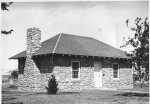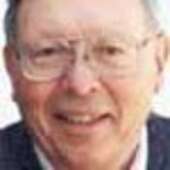Opinion
McCook's DAR Clubhouse
Monday, February 14, 2011

The DAR Museum in 1939.
In 1890 the United States was going through a period of increased interest in the nation's history, and very intense and visible demonstrations of pride in the USA. Differences between the North and the South had begun to blur after the Civil War and patriotism for the united country were strong and frequently demonstrated publicly.
Women in the United States still did not have the vote (that came in 1920 with the passage of the 19th Amendment to the Constitution). Nevertheless, women in the United States wanted to publicly express their patriotic feelings, but found themselves excluded by the men from Veterans' Organizations and other similar groups. Their natural reaction to the dilemma was to start their own organization, which they did on Oct. 11, 1890, with the creation of the D.A.R. (Daughters of the American Revolution).
There were three D.A.R. objectives set forth in that first meeting, and these objectives have remained uppermost for the organization for the last 120 years.

Howard and John Garrett in the Garrett Carpentry Shop in 1915.
1. History -- to perpetuate the memory and spirit of the men and women who achieved freedom during the American Revolution. 2. Education -- to carry out the injunction of Washington, in his farewell address to the American people -- "...to promote, as an object of primary importance, institutions for the general diffusion of knowledge, thus developing an enlightened public opinion." 3. Patriotism -- to cherish, maintain, and extend the institutions of American freedom, to foster true patriotism and love of country, and to aid in securing for mankind all the blessings of liberty.
The D.A.R. was set up as a rather exclusive organization, and has remained so to this day. In the past 120 years some 800,000 women have joined the D.A.R. Membership has been limited to women who can prove a lineal bloodline from an ancestor who aided in achieving Independence for the United States. This requirement has limited membership, and each year those able to prove the required ancestry make up a smaller and smaller percentage of the overall population.
The D.A.R. is involved in a number of very worthwhile projects. 1. Each year more than $1 million goes to six colleges with D.A.R. connections, in the South and Eastern parts of the US. $150,000 in scholarships are awarded to high school graduates to study in various fields. Only 2 of the 20 scholarships are restricted to D.A.R. members or their descendants. D.A.R. also provides some $100,000 in scholarships to Native American youth for college and summer camps in Oklahoma and Oregon.
The D.A.R. sponsors an American History Essay Contest for students from 5th grade through 8th grade. Winners are acknowledged regionally and national winners receive a cash award. (For years the local chapter sponsored such a contest in McCook in connection with the annual meeting of the High Plains Historical Association.)
From its beginning, in 1890, much of the D.A.R.'s strength has been in the South, where women of old Confederate families switched their loyalties and sentiment from the failed Confederate cause to the United States as one nation. Because of long held beliefs and customs, sentiment toward integrating the D.A.R. was slow in coming, and it was not until 1977 (when a Detroit woman of color, Kathryn Batchelor, as a Bi-Centennial project, researched her family tree and came up with the necessary proof of her ancestry dating to the Revolutionary War, with qualifications to insure her admittance into the D.A.R.. She became the first African-American member of the D.A.R.).
The membership of the D.A.R. over the years has been impressive and transcends political differences, from Susan B. Anthony and Clara Barton, who were founders of the group, to Ginger Rogers, Mary Baker Eddy, and Caroline Harrison, the wife of President Benjamin Harrison, to Laura Bush, Rosalyn Carter, Elizabeth Dole, Janet Reno, and Phyllis Schlafly. Eleanor Roosevelt, FDR's first lady, and a member of the D.A.R., invited Marian Anderson, the famed black soprano to sing in the White House in 1936. Later that same week Ms. Anderson was scheduled to sing at Constitution Hall, in Washington. At the last minute her concert was cancelled. A 1932 rule, adopted by the D.A.R., said that no person of color could perform at Constitution Hall. Mrs. Roosevelt, an active member of the D.A.R. immediately resigned from the organization. The discriminatory law banning blacks from Constitution Hall was quickly changed, but Ms. Roosevelt did not renew her D.A.R. membership.
The D.A.R. tends to be a pretty straight-laced, and a politically conservative organization. Its emphasis on connections to the founding fathers of our country has caused it to take a good bit of ribbing in the movies, in the press, and on screen, but the D.A.R. has not wavered from its mission to promote History, Education, and Patriotism.
The D.A.R came to McCook in 1912 and was immediately a popular women's organization in town. For a number of years the ladies met in varied locations -- individual homes, the Court House, the YMCA and church basements. However, on Sept. 11, 1939 the organization dedicated its very own meeting hall, the little stone façade building just north of McCook College, in Kelley Park, which has been much in the news lately, since it stands where the new MCC Sports Center is to be built.
In 1939 there were many new buildings being built in McCook, in Nebraska and across the nation by the WPA (Works Project Administration) -- part of President Roosevelt's New Deal Program. These projects benefitted communities and were built by local workmen. In McCook, the foreman for the D.A.R. building project was John Henry Garrett, the son-in-law of Thomas Moore (White House Grocery), and grandfather of McCook's Mary Poore.
Mr. Garrett was an active McCook builder in the years before World War II. He worked with his son (the cabinet maker) out of his own carpentry shop in the 200 block of West 1st St. and built a number of homes in and around McCook, including the home and photography studio of Tor Olson, on Norris at J. St. He was the contractor for the Band Shell in Norris Park (1917), and did the cement work and steps on the Barnett Memorial Methodist Church in 1927.
For a number of years the cozy little D.A.R. building in the park, with its fireplace, served as the meeting place for the organization, a museum for the artifacts that the members had gathered, and a work place where members could do research of family/area history.
In 1983 it was decided to take over one wing of the new High Plains Historical Museum on Norris Avenue for the D.A.R. Museum, and the park building was abandoned. There have been numerous suggestions for the building's use, by the college and other civic groups over the years, but none have worked out and for some time the building has just served as a storage place for hoses and yard equipment for Kelley Park.
Never the less, the historic building has its friends, who have been able to save the building. At a recent meeting Dr. Tubbs, of the Mid Plains Community College announced that the building would be preserved, and improved. It is to be moved just north of the South Shelter House in Kelley Park, where it can be used by groups who also use the Shelter House. It would seem to be a good solution, and acceptable to all.
Source: DAR website; Eleanor Roosevelt; Pictures courtesy Mary Poore

